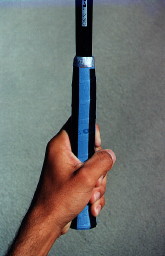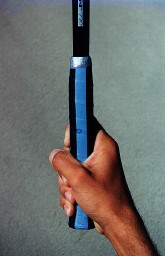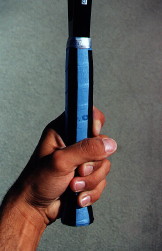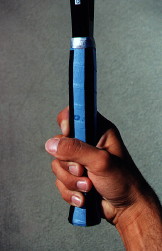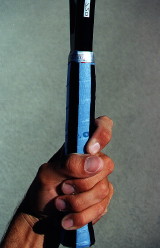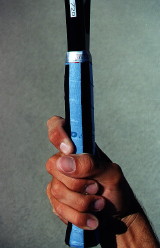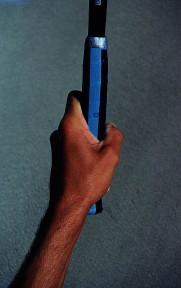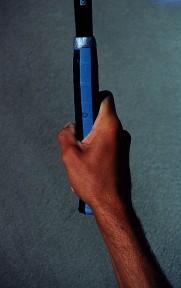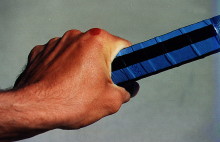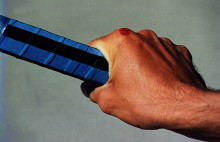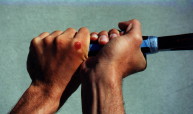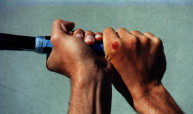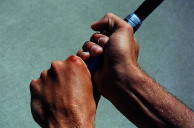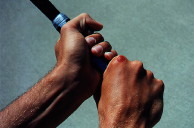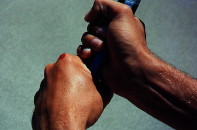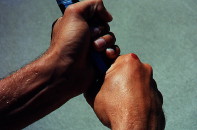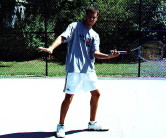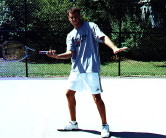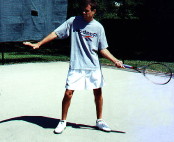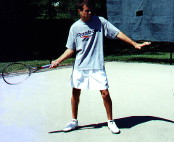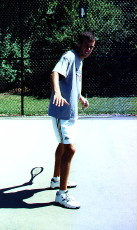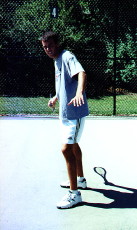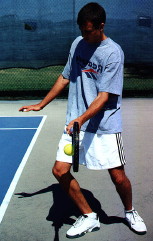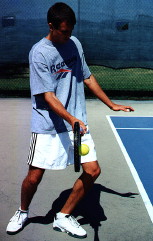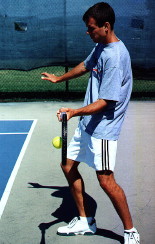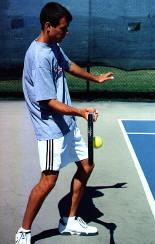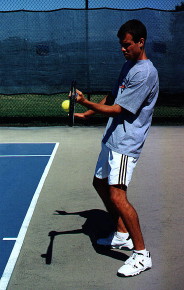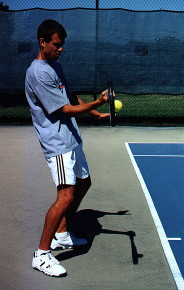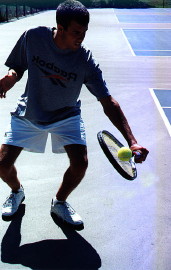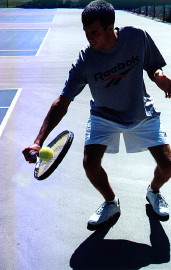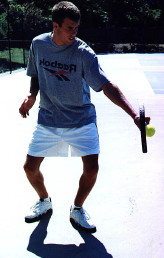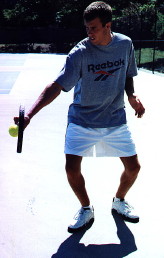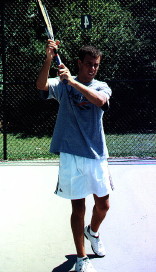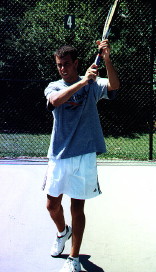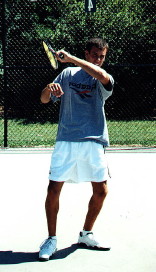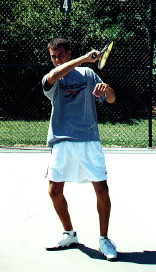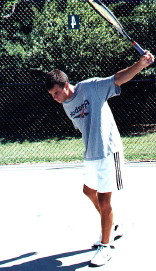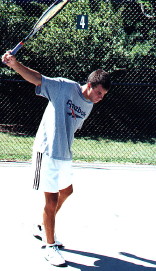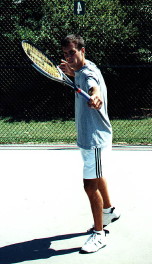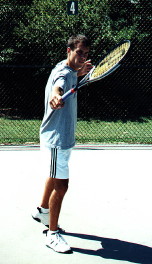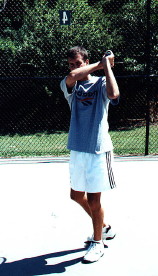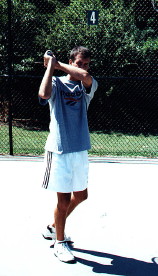November 2008 Article Turbo Tennis Archives:
Tennis Server
|

 |
Although we are in November and those of us north of the equator are probably experiencing some winter-like weather, this is not the time to abandon proper form development in one’s strokes. Indeed, this is probably the very best time to start to work on improving every stroke. Although we may not be playing this wonderful game as frequently as we do during the warmer months, we should make every effort to hit every stroke perfectly. If we can put the time in now, we can change and improve by the time those spring and summer months roll around again. Fall and winter are times for assessment and change in my mind. We all can improve our strokes. In fact, one of the things that I love most about this great game is that we never can be complacent. If we are, we may find some of our strokes deteriorate. More importantly, if we are complacent, we do not find ourselves moving forward. A good number of my readers are folks who are relatively new to the game of tennis. They, like me, are totally addicted to the wonders of this superlative sport! Frequently, these neophytes are in need of building a solid foundation with respect to strokes. Well, this month’s column will address what are the essential checkpoints associated with groundstrokes. These checkpoints have relevance to volleys, half volleys, serves and overhead. But, the groundstroke is the "bread and butter" of tennis. Without solid groundstrokes, the player is unable to return serve effectively or rally with authority. So, whether you are a seasoned "pro" or a novice, it behooves every player to review this checklist periodically. If you work on "discovery" and any associated corrections during your "off season," you will be ready to resume championship play come the spring and summer. There is a hierarchy to this checklist, and the following aspects are listed in the order of their "position" in this hierarchy. Please notice that I did not state, "in the order of their importance." Every one of these facets is important. Indeed, the last is the most important in my mind. However, things take place in a particular order when hitting a groundstroke. And therefore, first things should be placed first.
GRIP "Grip is everything!" Although I cannot remember where I first learned of this statement, I believe it originated with Rod Laver, although I am not certain that I have quoted him exactly. Even if not an exact quote, I firmly believe that the message is well founded.Everything in the mechanics of a stroke is built around the grip that one uses for the stroke. In that no two people are exactly the same, it is not surprising that there are differing grips for each stoke. Of course, some grips are more appropriate for the modern game than others. There are three grips that I would recommend for the forehand groundstoke: the Eastern Forehand Grip, the Semi-Western Grip and the Full Western Grip. The Eastern Forehand Grip is essentially the "shake hands with the racquet handle" grip that has been taught for many years. Focusing on the base knuckle of your dominant hand’s index finger (the knuckle that is located where the finger meets the base of the hand), the Eastern Forehand Grip places this knuckle on the side of the racquet handle. To arrive at this grip, simply spread your fingers open across the string bed on your racquet face. Then, just slide down slowly until you arrive at the handle. You should now be holding the racquet in the Eastern Forehand grip. (Note that you can click on each of the images in this article to pop up a larger, higher-resolution version.) The Semi-Western Grip is my preferred forehand grip. It places the base knuckle of the index finger on the bevel of the racquet handle that is between the side and the bottom. If you place the racquet handle on your foot with the head on the ground, bend over and pick it up by its handle, you will be holding the racquet in the Semi-Western Grip. The Full-Western Grip is where the base knuckle of the index finger is resting on the bottom of the racquet handle. If you pretend that the racquet is really a frying pan and hold the handle as you would a frying pan, you are using the Full Western Grip. To hit a forehand with this grip, you need to bend your wrist at the moment of contact to open the racquet face. Each of the above grips is used by pros on both of the tours. The Eastern Forehand grip is less likely to produce topspin than the others, but was essentially the grip used by Pete Sampras. It is not the most common grip in the modern game. But, this is not to suggest that adopting this grip as your primary forehand grip is wrong. The Semi-Western Grip seems to be the most common grip among pros. It naturally allows for the imparting of topspin, but is still will allow a player to hit a ball flatly and with power. It is not as "severe" a grip as the Full Western Grip. So switching to a backhand grip(s) is usually not a difficulty. The Full Western Grip is used by many pros. It automatically imparts lots of topspin. Of course hitting slice with this grip is very difficult. Clay court players often times choose this grip as their primary grip because of its high contact point (to be discussed later in this article). It is a bit more difficult to hit low bouncing balls with this grip if one does not bend one’s knees! Moving from the Full Western Grip to a backhand grip(s) can be a bit challenging for players…especially when returning serve. The decision regarding which of the above grips will be your primary forehand grip should be based on "feel," comfort and determining which grip seems to allow for the most control. Any of these can be hit with pace. So, how the grip "fits" and how well one can control forehand groundstrokes should be the main deciding factors. One-handed backhands usually take one of two grips, the Continental Grip or the Eastern Backhand grip. The Continental grip places the index finger’s base knuckle on the bevel between the side and the top of the racquet handle. The so called, "Hammer" grip is a great way to arrive at a Continental Grip. Just hold the racquet handle as if you were using the racquet as a "hammer." Pretend that you are hitting a nail into the ground or a wall with the side of the racquet head. Once you have this hammer grip, simply move your index finger up the handle a bit toward the racquet head. You now have a true Continental Grip. The Continental grip is great for hitting slice, but can be use to hit a one-handed, driving shot. The Eastern Backhand Grip is probably the most common grip among pros who favor one-handed backhands. The index finger’s base knuckle is really placed on the top of the racquet handle. To get this grip, simply put the racquet above your head and a bit in front of your body using your non-dominant hand. Keep the racquet head positioned so that the strings are facing directly at the ground. Now, simply reach up with your dominant hand and grab the racquet handle. You are now holding the racquet in the Eastern Backhand Grip. This grip can be used to hit slice, flat backhands and is great for imparting topspin. Thus, it is probably the grip of choice for modern one-handed hitters. Two-handed backhand grip combinations vary greatly. Regarding the dominant hand, players will hold the racquet with any of the three forehand grips described above. I use a Continental Grip on my dominant hand (right) when I hit my two-handed backhand. Why? Well, every player has to be able to hit one-handed slice. I find that using a Continental Grip in my combination allows me to drop my left hand and be automatically ready to hit this one-handed slice. Really, the non-dominant hand’s grip is the more important grip when hitting the two-handed backhand. Spend time finding a grip for this non-dominant hand that feels as though you could hit the entire stroke with your non-dominant arm. Then, add the other (dominant) hand to the handle. One needs to experiment a bit to discover the right non-dominant hand grip. Once this is found, add the dominant hand, and again, experiment with differing forehand grips. Eventually, you will find a combination that feels right. There are variations within each of the above grips. Your positioning may vary a little bit from the "ideal." Everyone’s hands vary and different players use different racquet grip sizes. In addition, each manufacturer shapes the racquet handle a bit uniquely. Don’t worry about having a "pure" grip. Rather, make sure the grips feel solid and work for you. The Two-Handed Grip with Dominant Hand in Eastern Backhand Grip The Two-Handed Grip with Dominant Hand in Continental Grip The Two-Handed Grip with Dominant Hand in Eastern Forehand Grip STANCE Let’s be clear. When playing matches, there are many times when a player is forced to hit a stroke from a stance that is awkward. If a player is scrambling to get to a ball, he/she hits with whatever stance possible. "Emergency" situations occur. However once a grip is in place for a given stroke, there are stances that are more ideal for this grip than others. This is not to say that if you are out of an ideal stance for a given stroke/grip combination that you cannot hit effectively. Rather, it is to suggest that when you are not in ideal stroke/grip stance, you need to hit more defensively. These are not the times to go for winners. Keeping oneself in the point should be the primary goal. My nomenclature for stances may vary a bit from other tennis writers. So, I must begin by clarifying what stances I see existing.
For each stroke/grip, there is an ideal stance. These ideals can vary a bit, but once you decide upon a grip for a given stroke, you will probably discover that the best shots hit with this stroke/grip combination will be struck from the listing below.
I should note that most players do not vary their forehand grips when in a less than ideal stance. By this I mean that a player is not likely to move from a Western or Semi-Western Forehand Grip to an Eastern Forehand Grip when she/he is out of an ideal stance. There simply isn’t sufficient time, and thus, such changes can find the player midway in a grip change when actually making contact with the ball. On the backhand side, a player who hits with a two-handed backhand may benefit from having her/his dominant hand grip the handle with a Continental Grip. Why? Well, if the player is forced to stretch for a shot or decides to hit the one-handed slice (Every player needs to be able to hit the one-handed, backhand slice.), she/he need simply take the non-dominant hand off the racquet handle. Now, the player is properly prepared to hit the one-handed, backhand slice. By the way, when a player is stretched out on the backhand wing, he/she is most likely to be in a closed stance. This is the ideal stance for hitting with the Continental Grip. CONTACT POINT When making contact with the ball, there is an ideal contact point for each stroke/grip combination. Now, this is not to say that one can always find a way to be making contact perfectly. But knowing where the ideal contact point is for each of your groundstrokes is critically important information. I see many players going for winners when the situation does not allow them to make ideal contact with the ball. To me, this is very foolish. My rule is simple. I will not go for a winner nor will I hit a ball with maximum pace unless I am certain that I can make contact with the ball given the stroke/grip combination’s ideal contact point. Adhering to this rule will automatically help a player play percentage tennis, and thus, make fewer errors. Let’s face it. Tennis is not a game of winners. It is a game where the victor probably makes fewer errors. Here, however, are the general guidelines that seem to be associated with the aforementioned stroke/grip combinations.
STROKE FINISHES My friend, David Ranney, constantly promotes the importance of stroke finishes, and I think he is correct in giving this aspect of a stroke such emphasis. When I have traveled to the famous tennis academies, I have noted how frequently the coaches at these schools will remind players to finish correctly. If for each stroke a player finished exactly the same (assuming the finish is correct), the player would invariably experience greater consistency and control. Of course, there are times when each stroke cannot be finished ideally. But, the goal should be to try and make each finish as proper and consistent as is possible. Each grip/stroke combination has its own ideal finish. Your ideal finish may vary a bit from what is pictured below. But, it should probably be pretty close. EASTERN FOREHAND GRIP FINISH THE SEMI-WESTERN AND WESTERN GRIP FINISHES (Both of these grip/stroke finishes have very similar attributes. Each player must discover for herself/himself exactly how the finish should be completed. The most important attributes are to make certain that the finish is either an over-the-shoulder finish, or a bit less common but more likely to be appropriate for strokes using the Western Forehand Grip, players may finish in a windshield wiper-like manner. In this latter finish, the racquet crosses the front of the body very similarly to the motion of a car’s windshield wipers. However, the more common finish for both of these grip/strokes is what is pictured below.) THE EASTERN BACKHAND GRIP FINISH THE CONTINENTAL GRIP FINISH TWO-HANDED BACKHAND FINISHES (Here again, the finish for the two-handed backhand should be pretty much the same regardless of the grip combination used. There will be variances in the ideal, to be sure. However, the concept of finishing as if the player was throwing a sack of potatoes over his/her shoulder is a good concept to keep in mind as he/she discovers the exact finish that works best.) My strong belief is that each player should constantly work on improving her/his stroke form. Certainly, there are many things that need to be considered in perfecting these stroke forms. Footwork and backswing are just a few of the elements not addressed in my column this month. However, the key factors that to which each player must attend are grip, stance, contact point and finish. If these are in proper form and executed on a consistent basis; the player will invariably make fewer errors. Errors, not winners, at every level of the game determine who wins. Recognizing that newer players may have difficulty arriving at grips, I have prepared a video (albeit not too sophisticated) that will illustrate some simple ways to arrive at holding the racquet in the aforementioned grips. Use these techniques to start at using a particular grip. Then, check your grip against the still images provided above. All grips must be tailored to suit a player. Some grips may be totally inappropriate for some players. However, seasoned players may find that adding some grips to their options allows for greater success on the courts. The bottom line is clearly that synchronous strokes are essential to playing better tennis. No one can hit every groundstroke with the ideal elements in sync. Still, the goal should be to try. Synchronous stokes yield more consistency. More consistency yields fewer errors. Fewer errors yield more wins. More wins will invariably make you a tennis overdog! PS. I have produced a little video that will hopefully help those of you who believe that finding the aforementioned grips confusing and difficult. Hopefully, these simple ways to "get a grip" will make finding these grips easier.
1996 - 2002 | 2003 - Present
This column
is copyrighted by Ron Waite, all rights reserved. Questions and comments
about these columns can be directed to Ron by using this form.
Ron Waite is a certified USPTR tennis instructor who took up the game
of tennis at the age of 39. Frustrated with conventional tennis methods
of instruction and the confusing data available on how to learn the
game, Ron has sought to sift fact from fiction. In his seven years of
tennis, Ron has received USTA sectional ranking four years, has successfully
coached several NCAA Division III men's and women's tennis teams to
post season competition, and has competed in USTA National singles tournaments.
Ron has trained at a number of tennis academies and with many of the
game's leading instructors.
In addition to his full-time work as a professor at Albertus Magnus
College, Ron photographs ATP tour events for a variety of organizations
and publications. The name of his column, TurboTennis, stems from his
methods to decrease the amount of time it takes to learn and master
the game of tennis.
|



October 2022 Tennis Anyone: Patterns in Doubles by John Mills. September 2022 Tennis Anyone: Short Court by John Mills. |
 You will join 13,000 other subscribers in receiving news of updates to the Tennis Server along with monthly tennis tips from tennis pro Tom Veneziano.
You will join 13,000 other subscribers in receiving news of updates to the Tennis Server along with monthly tennis tips from tennis pro Tom Veneziano. 
